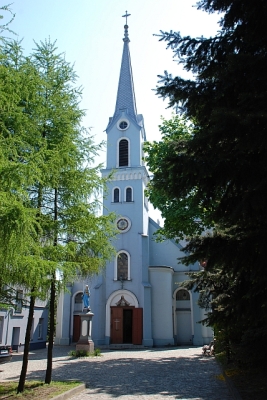
This was the longest street in the ghetto. One of the German guardhouses was located at its most southern end, in the former security post of the Biedermann palace. (The second guardhouse was located at the second end of Franciszkanska Street at the corner of Okopowa). Many important institutions had their offices on this street, especially at its southern end, where elegant tenement buildings once stood. The building at 13/15 Franciszkanska St., at the corner of Smugowa Street, housed a school until October 1941. Later, the Jews from Prague, known as Collective "Prague II" were housed here.
After the wave of deportations to the death camp in Chelmno-nad-Nerem, the underwear and clothing departments were placed here.
 The Church of Mariawits, a religious Christian sect established in Poland, was not used in the first phase of the ghetto's existence, as was the case with other churches in the area.
Later, it was turned into a warehouse. Interestingly, the statue of the Virgin Mary, positioned in front of the church, survived the ghetto years. It was encased with planks.
The Church of Mariawits, a religious Christian sect established in Poland, was not used in the first phase of the ghetto's existence, as was the case with other churches in the area.
Later, it was turned into a warehouse. Interestingly, the statue of the Virgin Mary, positioned in front of the church, survived the ghetto years. It was encased with planks.
The old parish buildings that once stood at 27 Franciszkanska St. became the headquarters of the 1st District of the Order Service, or the Jewish police [see: The Jewish Police], which began operations in May 1940. The Department of Education, which oversaw the schooling of children and youth, was in the same building. It also organized and supervised summer camps and day camp for children in the Marysin area of the ghetto. Two schools operated -at the same address as well.
A great plantation, where a summer day camp existed in 1940, was located behind the building, but later the property was divided and sold.
Beginning March 16, 1940, the Summary Court was located at this address. It reviewed cases of people charged with serious crimes, which included sabotage and incitement. The sentence was always read by the judge in the presence of two jurors, without the participation of either a prosecutor or a defense attorney.
In the autumn of 1941, the Jewish deportees from Czechoslovakia (Collective "Prague IIIb") were held here. When the deportations to Chelmno-nad-Nerem began, the Displacement Committee operated here from January 16 until April 2, 1942.
Announcement No. 233 by the Eldest of the Jews, posted on March 15, informed the ghetto population about the Summary Court starting March 16. This institution is located at 27 Franciszkanska St. According to the announcement, the Summary Court is a totally independent body, and its task is to fight offences threatening the public interest. The Summary Court’s sessions will be conducted by two teams, consisting of a judge and two jurors, appointed by the Chairman.
The trials will not be preceded by any investigation. Neither the prosecutor nor the defense attorney will attend the trials. The judges will pronounce the sentences based only on their own convictions.
The Chronicle of the Lodz Ghetto, March 10-24, 1941, Vol. 1, p. 88.
A sentence was handed down by the Summary Court in which a prison guard, Jakub Szeps, was condemned to six months of hard imprisonment for taking bribes from prisoners' families who used him as a go-between to hand food parcels over to their relatives.
The Chronicle of the Lodz Ghetto, April 4, 1941, Vol. 1, p. 110.

 Home
Home
